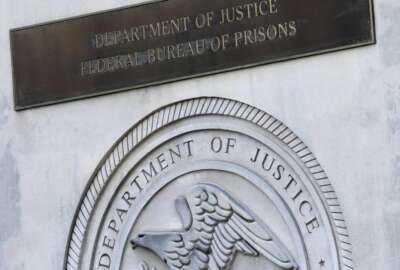

A persistent problem for the federal Bureau of Prisons is the rate at which former convicts come back. 45% of released inmates end up re-arrested within three...
A persistent problem for the federal Bureau of Prisons is the rate at which former convicts come back. 45% of released inmates end up re-arrested within three years. A 2018 law required the Justice Department to measure individuals’ risk of recidivism and take stapes to prevent it. The Government Accountability Office has taken a new look at the program, and found room for improvement. The Federal Drive with Tom Temin spoke with GAO’s director of homeland security and justice issues, Gretta Goodwin.
Interview transcript:
Tom Temin And it looks like they have a couple of problems at BOP, at the Bureau of Prisons. One is how they’re managing the data surrounding the management of individuals in their custody, and also what they’re delivering such that people still come back at this almost 50% rate of recidivism. So what were you looking at in this study?
Gretta Goodwin So we were asked to look at how the BOP was managing the risk and needs assessment that they’re doing when individuals enter the facilities. We were also looking at the different types of programs that they might have been providing, people who are incarcerated, to help address issues around recidivism. And also ensuring that those programs were indeed the right programs for the individuals. We, of course, provided recommendations on how to improve all of these.
Tom Temin And what were the issues that they were not using the data carefully enough or thoroughly enough to understand what each individual needs? They’ve got about 150,000 people in the federal prison system, and they need to tailor services for each one?
Gretta Goodwin Yes. So how this works, when an individual enters the facility BOP, I think, would say from day one, the focus should be on reentry. And so when an individual enters the facility, there’s a needs assessment that is done for them to get a better understanding for what they might need, whether it’s literacy, whether it’s anger or hostility management, like what might they need to get them prepared to reenter. And then BOP goes about providing services to help with that. So they might provide anger management classes. They might provide some type of some literacy classes to help individuals be better prepared that when they come out, they can reenter society more successfully. What we were finding is that this wasn’t always being done consistently and as thoroughly as we would like to see.
Gretta Goodwin We were also finding that there’s this thing called time credits. So when an individual is participating in different types of activities, they’re given time credits to help shave off some time on their prison sentence. And so what we were finding was the types of programs that were being made available, weren’t as comprehensive. The types of data that were being collected about what these needs were, also weren’t as comprehensive as they could have been. And so when you have that issue, if you don’t really have a good sense for what the individual needs, how can you effectively tailor the programs to help them? And then a major thing that we found, was even when that was happening, there was not a lot of evaluation being done. So evaluating whether these programs were indeed successful and then continuing to monitor. And so it was an evaluation and monitoring concerns that we also had that we made recommendations on.
Tom Temin It’s almost like they have to operate as a long-term hospital in that sense, because every inmate is different and you have people ranging from horrible, violent people that are in the supermax, to say financial criminals that are in minimum security. And so, probably people never get out of supermax or maybe they go from there to a regular high security prison. The anger management and violence management might be needed, whereas people that are in there for so-called white collar crimes might need moral training or something. But they have a totally different set of issues. Is that part of their challenge?
Gretta Goodwin This is a big challenge for the agency. And you’re absolutely right, each person is different. And the agency, the BOP needs to find a way to address the needs of approximately hundred and 58,000 individuals that they are responsible for the care and custody of. So we do recognize that this is a challenge for them. But because this is what is required under the First Step Act, and also what is required if you’re wanting to ensure that people can reenter society, then you have to pay attention to these. And so when someone comes in, when an individual comes into the prison facility, from day one, assessing what their needs are. Paying attention to what some of the risk factors might be for them, in terms of recidivism. And then making certain that the programs are made available. We’ve reported in the passed on BOP has a number of staffing challenges, and that might play some part into this. Being able to provide all of these programs, you’ve got to have the staff available and around to do it.
Tom Temin We’re speaking with Gretta Goodwin. She’s director of Homeland security and Justice issues at the Government Accountability Office. In some cases, they have the challenge of simply maintaining basic order in an institution, let alone seeing to the individuals, cares and needs. Fair to say?
Gretta Goodwin Absolutely. And this adds an additional challenge. When we did the staffing report, we talked about this, in terms of sometimes you’ve got officers who are doing double duty. You’ve got you’re augmenting or having folks whose main job isn’t a correctional officer, having to come in and provide some assistance there. And that is taking staff away from these other duties of providing the programs. If you need someone teaching the classes or managing the classes, that’s happening as well. And so this is kind of a, it’s a massive operation, the Bureau of Prisons is a massive operation. But again, if the focus is on ensuring that people can come out and reenter successfully, you’ve got to find ways to manage these programs. We’ve got to find ways to ensure that people’s risk and their needs are being calculated properly. You’ve got to find ways to ensure that the programs are being made available and that people are participating in those programs. And then you’ve got to find ways to ensure that the evaluation of those programs, to test whether they are actually doing what their what they are supposed to do. And then you’ve got to monitor to see like who’s taking what, who’s doing what and how successful are these programs are for them.
Tom Temin And you had a fairly long list, eight recommendations for the bureau. Just summarize what it is you’re trying to get them to do. And what was the response?
Gretta Goodwin So we did. We had eight recommendations. And basically what these recommendations are about, are ensuring that the first step back can be successfully implemented. Some of them are foundational. One of the recommendations we have is on ensuring that they maintain complete and accurate data, and also making that readily available. Because one of the things we were finding, is for the staff who are going in to look to see like what’s needed, where are the data. It needs to be readily available for them so that they can then take that and apply that to what they need to do to create these programs. But anyway, so the recommendations speak to maintaining complete and accurate data, ensuring that the monitoring efforts are happening. Because if you’re developing these mechanisms, you need to make certain that you’re incorporating them properly throughout. And also, on an ongoing basis, making certain that you have evidence based recidivism reduction programs. And so when we talk about ensuring that you have programs, you need to make certain that there are recidivism reduction based kinds of programs. And those are the programs that you absolutely want to be evaluating and the programs you want to be monitoring.
Tom Temin In some ways, do you get the sense that the way that prisons are operated is a really good barometer of the way society operates? Yes, prisoners are people that have earned punishment. But in that sense, it makes them the most vulnerable people, among the most vulnerable types of people. And therefore, proper care within the context of what is a punishment situation is a reflection of our humane values. Or is that beyond the scope of the report?
Gretta Goodwin So that is beyond the scope of the GAO report. But again, BOP is charged with the care and custody of about 150,000 individuals. And in doing that and taking on that charge and being and taking on that responsibility, there are many different things that they’re going to have to be paying attention to. When an individual enters the facility, they’ve got to do that assessment to see what that person needs. If it’s literacy, if it’s anger management, if it’s skills, job skills, training, like what do they need? And then you have to provide those programs to ensure that they’re getting what they’re need. Throughout that process, there needs to be ongoing evaluation and ongoing monitoring so that BOP has a good sense for whether those programs are effective at all. And then once they know that, they might need to target differently, they might need to create additional programs or they might need to just do some modifications. When we were doing this report, and our recommendations speak to this. If that can’t get done, then there will always be a question about how effective things are.
Tom Temin Sure. And did they generally agree with the findings? And what comes next?
Gretta Goodwin So there were eight recommendations, and they agreed with all but two of them. And the two that they disagreed with focus on monitoring and evaluating. And in particular, it focused on having a good sense for what we call unstructured productive activities. So that means an individual in the facility can earn time credits and that would shave off time for their sentences, from their sentences. But they have to be engaged in productive activities. Some of those activities are what BOP will call unstructured. We asked, What does that mean? What does that look like? Do you know? Do you have a list of those unstructured productive activities? And in their response to us, they stated that there wasn’t really a need for that. We maintain that there is, because if you are a person who’s incarcerated, and you’re going and taking these programs and participating in these activities, you need to have a good sense for what’s going to get you the time credits that will help you shave off time on your sentence. And then, of course, after you have that list of unstructured activities, we were asking that they evaluate whether they are effective.
Copyright © 2025 Federal News Network. All rights reserved. This website is not intended for users located within the European Economic Area.
Tom Temin is host of the Federal Drive and has been providing insight on federal technology and management issues for more than 30 years.
Follow @tteminWFED


